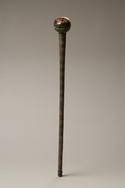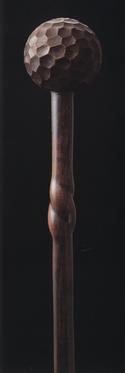
The patrons of skilled carvers valued inventive variations in the treatment of knobs and other details, and were probably prepared to pay more for examples with finely carved decorative motifs.
Some carvers enhanced the impact of these features through pokerwork, or by introducing subtle shifts in the depth of the carving of raised patterns.
From time to time, women also added beadwork details to personalise the staffs of their husbands and other loved ones.

The woods employed in the production of staffs varied from one area to another depending on availability. Although hardwoods were generally reserved for chiefs and kings, carvers appear to have worked with specific types of wood for a variety of reasons.
In some cases their choices were informed by the colour of the wood, in others by the way the grain responded to the simple tools they used to define decorative details.
Hard wood staffs often have details incised onto, rather than carved into, their surfaces. Skilled carvers exploited these differences in the quality of the woods they worked with in the interest of enhancing the aesthetic impact of their often highly inventive solutions to decorating details like the knobs of prestige staffs.

There was a widespread practice throughout southern Africa of carving snakes spiralling up the shafts of staffs. Staffs such as these were prestige items, indicating the status accorded to chiefs and ritual specialists.
The skill of makers of staffs like this one is evident in the way the stem forms an open loop before the intertwining snake motif is resumed.

This knobkerrie is unusual because of the materials used to fashion and embellish the head. Clearly sensitive to the decorative potential of combining different colours and textures, the carver produced an attractive inlay pattern by using animal horn in combination with brass and copper details.

The large variety of motifs found on prestige staffs is indicative of the inventive imagination of the carvers who produced them. Staffs like this one underline the remarkable abilities of carvers who perfected the skill of balancing simple geometric forms.
Zulu-speaking communities clearly valued these qualities, pointing to keen aesthetic preference for clean lines and minimal forms.

There is a marked and no doubt intentional contrast between the deeply faceted head of this knobkerrie and the velvety double twist on the shaft. In most cases, carvers confined decorative details to a fairly short section of the upper end of the shafts.